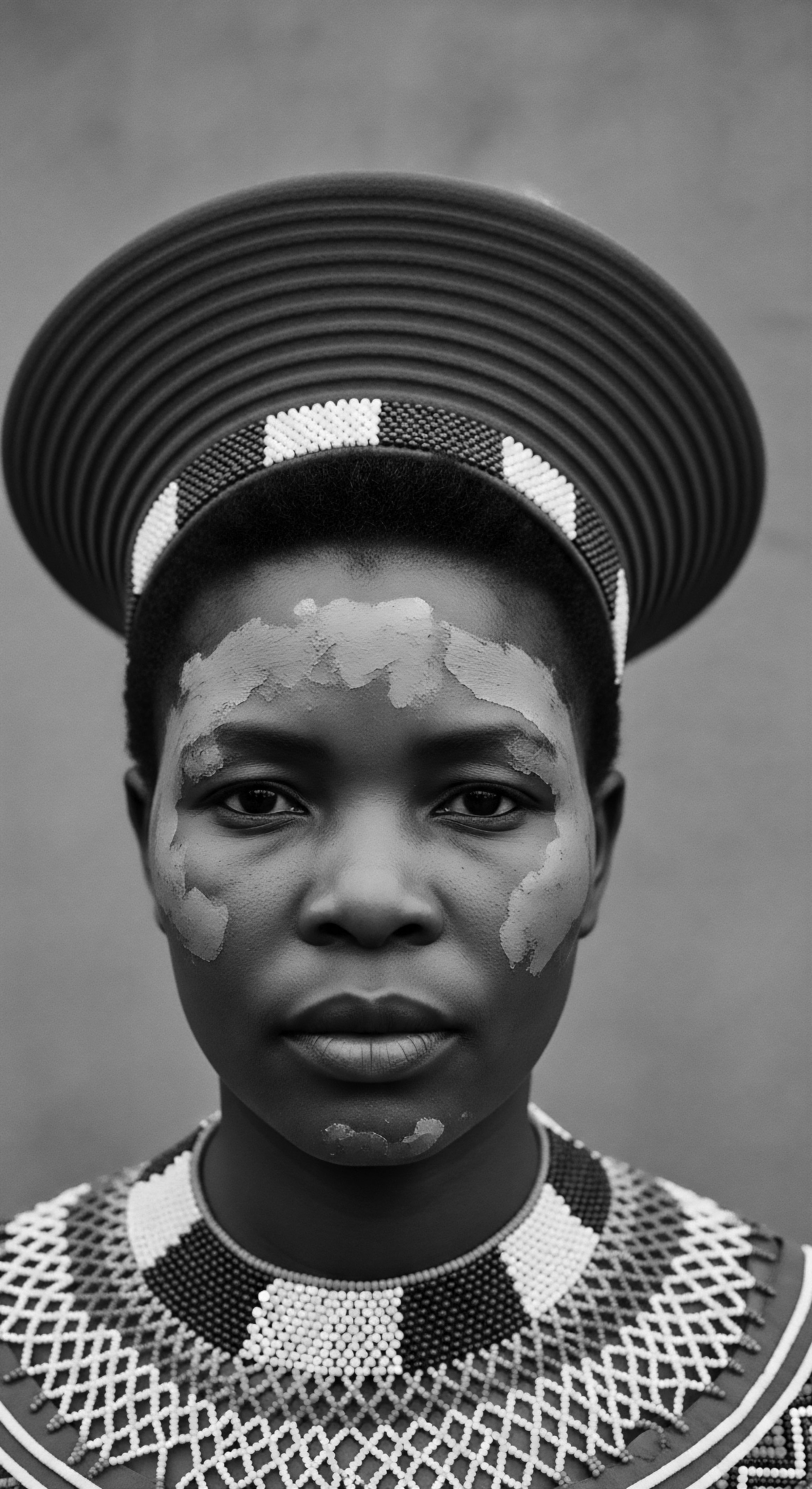
Fundamentals
The concept of Food Heritage, when observed through the sensitive lens of textured hair traditions, encompasses a profound explanation of how ancestral wisdom, deeply rooted in indigenous plant knowledge and resourcefulness, shaped the very fabric of hair care. It speaks to the elemental connection between the earth’s bounty, the practices of cultivation and preservation, and the intrinsic health of our hair. This understanding transcends mere sustenance for the body; it extends to nourishing the hair fiber, scalp, and spirit, recognizing them as integral parts of holistic wellbeing.
From the sun-drenched savannas to the lush riverbanks, our foremothers and forefathers discerned the inherent properties of local flora and fauna. They learned which seeds, leaves, roots, and fats possessed the gentle strength to cleanse, the hydrating touch to soften, and the protective shield to fortify strands. This ancestral intelligence represents a powerful designation of natural elements, transforming them from simple sustenance into potent elixirs for hair.
The core of this Food Heritage is often found in the kitchen or communal gathering spaces, where ingredients for daily meals might also be prepared for a fortifying hair mask. Think of the rhythmic pounding of plantains, the slow rendering of rich butters, or the drying of herbs under the watchful sun—each step a testament to an intricate relationship with nature. This holistic understanding of resources, where nothing was wasted and everything held potential, forms the bedrock of Food Heritage as it pertains to hair.
Food Heritage for textured hair illuminates how ancestral wisdom, derived from the earth’s provisions, organically shaped the profound practices of hair nourishment and protection.

Echoes from the Source ❉ The Genesis of Hair Nourishment
The early human story intertwines intimately with the natural world, and in countless indigenous cultures, the journey of hair care began with an intimate observation of the surrounding environment. Our ancestors, particularly those in African and diasporic communities, developed an unparalleled understanding of the plants, oils, and earth-derived compounds that held the promise of vibrant, healthy hair. This was a process of intuitive exploration, passed down through generations, often through oral tradition and hands-on teaching within the communal setting.
Consider the earliest forms of hair dressing. Before manufactured concoctions, before chemical processes, there was the soil, the sun, and the living green things. The interpretation of Food Heritage here speaks to the foundational recognition that what sustains the body can also sustain the hair.
Fatty acids from fruits like the avocado, mucilage from plants like okra, or saponins from soap berries, all were identified, processed, and applied with intention. This foundational knowledge was born of necessity, observation, and a deeply felt respect for the planet’s offerings.
- Shea Butter ❉ A timeless staple, rendered from the nuts of the shea tree, its emollient properties made it a cherished sealant and moisturizer for coils and curls.
- Coconut Oil ❉ Prevalent in many tropical regions, its ability to penetrate the hair shaft has been revered for centuries, a true gift from coastal palms.
- Aloe Vera ❉ Used for its soothing and hydrating qualities, the clear gel from this succulent plant has long provided relief and moisture to irritated scalps.
- Hibiscus ❉ The vibrant petals and leaves, often used for teas, also yield a mucilaginous rinse that conditions and adds luster to hair.

The Earth’s Pantry ❉ Ingredients and Their Purpose
Within the scope of Food Heritage, the “pantry” extends beyond edible goods to encompass all natural resources consciously applied to the hair. The delineation between food and medicine, sustenance and cosmetic, often blurred in traditional contexts. A root used to flavor a dish might also be boiled to create a restorative hair rinse. This purposeful use of elements, often seasonal and locale-specific, offers a powerful statement about sustainable living and an intimate connection to one’s ecological surroundings.
The knowledge of which ingredients to use, how to prepare them, and when to apply them was not arbitrary. It was a rigorous form of empirical science, developed over millennia. This sophisticated understanding explains why certain traditional methods, often dismissed by colonial perspectives, are now being validated by modern trichology.
For instance, the understanding that certain plant proteins can strengthen hair or that specific oils can reduce transepidermal water loss. The essence of Food Heritage, in this context, is the inherited wisdom of these practical applications.
| Traditional Ingredient Black Soap (Alata Samina) |
| Historical/Cultural Use (Hair) Gentle cleansing for scalp and hair; often infused with plantain skins and cocoa pods. |
| Contemporary Relevance (Nutritional/Hair Science) Rich in potassium and iron, providing a natural source of minerals. Its saponins effectively cleanse without stripping. |
| Traditional Ingredient Avocado |
| Historical/Cultural Use (Hair) Deep conditioning and moisture retention; mashed fruit applied as a mask. |
| Contemporary Relevance (Nutritional/Hair Science) High in monounsaturated fats (oleic acid), vitamins E and D, which nourish scalp and strengthen hair. |
| Traditional Ingredient Rice Water |
| Historical/Cultural Use (Hair) Hair strengthening, growth, and shine; fermented water used as a rinse. |
| Contemporary Relevance (Nutritional/Hair Science) Contains inositol, a carbohydrate shown to repair damaged hair and protect it from further harm. |
| Traditional Ingredient These ancestral ingredients represent a continuous lineage of care, where the earth's provisions were intuitively understood for their profound benefits to textured hair. |

Intermediate
Moving beyond the foundational understanding, the intermediate meaning of Food Heritage in the context of textured hair care deepens our appreciation for its cultural significance and adaptive resilience. This isn’t a static collection of ancient recipes; it is a living, breathing testament to ingenuity and survival, especially within communities that have faced historical displacement and cultural disruption. The Food Heritage, in this more intricate sense, represents a portable cultural memory, a set of practices that traveled with people, adapting to new lands while retaining the profound sense of ancestral connection.
The interpretation of this heritage includes the evolution of practices across diasporic communities. As people of African descent were forcibly dispersed, they carried with them not only their stories and their spirit but also their embodied knowledge of how to care for their unique hair textures using whatever natural resources were available. This forced adaptation led to the creation of new Food Heritage expressions, blending inherited wisdom with novel ingredients found in new geographical locales. This demonstrates a powerful form of cultural syncretism, where ancestral practices found new life and new forms.

The Tender Thread ❉ Intergenerational Transmission of Knowledge
The heart of Food Heritage is often found in the intimate, unwritten lessons passed from elder to youth. This transmission of ancestral hair wisdom, particularly in Black and mixed-race families, frequently occurred in communal spaces—the porch swing, the kitchen, or the salon chair—where stories, techniques, and shared experiences were woven together. The preparation of hair treatments from raw ingredients became a ritual, a moment of connection that transcended mere grooming. It became a profound statement of identity, community, and continuity.
Consider the careful measurement of ingredients, the specific kneading motions, the precise application techniques—each step an explication of a deeper understanding. This was not a standardized, scientific procedure in a laboratory, but a deeply felt, experiential process, perfected over generations. This collective memory, preserved through practice, embodies the true essence of Food Heritage, showcasing how traditional knowledge systems maintained health and cultural identity.
The deep significance of Food Heritage unfolds through the intergenerational transmission of hair care wisdom, transforming ingredients into cherished rituals that affirm identity and community.

Adapting to New Lands ❉ Food Heritage in the Diaspora
When African peoples were brought to new continents, they faced unfamiliar botanical landscapes. Yet, their deep understanding of Food Heritage allowed for remarkable adaptation. In the Caribbean, new ingredients like soursop leaves, guava, or even molasses, found their way into hair care routines, mirroring the properties of plants left behind on African soil.
In the Americas, ingredients like cornmeal (for cleansing) or various native berries (for conditioning) were ingeniously incorporated, blending ancestral techniques with newfound resources. This creative resourcefulness highlights the resilience inherent in Food Heritage.
The meaning of Food Heritage here is not just about the specific plant or ingredient but about the underlying methodology ❉ observing nature, identifying beneficial properties, and applying them with intention. This adaptive spirit underscores how textured hair, often a marker of identity and resistance, remained deeply cared for through these culturally resilient practices.
- Okra ❉ Introduced to the Americas from Africa, its mucilaginous pods were used for their slip, acting as a natural detangler and hydrator.
- Molasses ❉ A byproduct of sugarcane, its mineral content was sometimes incorporated into hair rinses for strength and shine in Caribbean traditions.
- Flaxseeds ❉ While not indigenous to all diasporic regions, their widespread cultivation allowed for their adoption, yielding a gel for curl definition akin to traditional seed-based extracts.
The integration of new elements into existing frameworks of hair care traditions speaks volumes about the dynamic character of Food Heritage. It tells a story of survival, innovation, and an unwavering commitment to maintaining cultural practices, even in the face of immense adversity. The practices became quiet acts of defiance, preserving a piece of self and ancestry in a world that often sought to erase it.

Academic
The academic understanding of Food Heritage, particularly concerning textured hair, transcends a simple historical account of ingredient usage. It operates as a complex construct that delves into epistemic justice , ancestral resilience , and the biocultural co-evolution of human practices and natural resources. This refined meaning unpacks how indigenous knowledge systems, often dismissed or marginalized by colonial scientific paradigms, held sophisticated insights into the elemental biology and restorative capacities of plants, shaping hair care through generations. It is a profound exploration of knowledge transmission, resource management, and the deep semiotics of self-presentation within diverse human experiences.
From an academic perspective, Food Heritage constitutes a form of embodied ecological knowledge. It represents centuries of empirical observation, trial, and iterative refinement concerning the interaction between specific botanicals, human physiology (particularly scalp and hair biology), and environmental conditions. The intellectual rigor behind discerning which plant derivatives offer slip, which provide protein, or which cleanse gently, speaks to a sophisticated botanical understanding, albeit one articulated through practice rather than formal scientific nomenclature. This profound explication underscores the continuous thread of human ingenuity in utilizing natural resources for wellbeing, a thread often invisibly woven through daily rituals.

The Biocultural Co-Evolution of Hair and Sustenance
The connection between the human body, its adornment, and the immediate environment has always been inextricable. In the context of textured hair, the Food Heritage illustrates a biocultural co-evolution ❉ as human hair textures adapted to various climates and sun exposures, so too did the communities develop symbiotic relationships with local flora to maintain that hair’s unique characteristics. This isn’t merely about finding a plant to “fix” hair; it’s about a deep, reciprocal relationship where the environment shaped hair, and humans, in turn, innovatively shaped their environment’s resources to care for their hair. This signifies a nuanced understanding of biological needs met by culturally specific resource utilization.
For example, the Basara Arab women of Chad offer a compelling case study of this intricate relationship, one that directly addresses the concept of Food Heritage as both a resource system and an ancestral practice. Their traditional hair care regimen, centered on Chebe powder and Karkar oil , speaks to a localized botanical wisdom that has sustained hair length and health for centuries. Chebe, derived from the seeds of the Croton zambesicus plant (also known as Lavender Croton), is a staple in their hair rituals.
While the plant itself is not consumed as food, its seeds are meticulously processed—roasted, ground, and mixed with other ingredients like mahlab, cloves, samour resin, and scented oil—to form a potent powder. This powder is then combined with Karkar oil, typically made from animal fat (like cow fat) infused with fragrant oils and sometimes honey, linking directly to a broader concept of utilizing local, often food-adjacent or derived, resources.
The Basara Arab women’s Chebe tradition offers a powerful case study, illustrating how Food Heritage extends beyond mere edible sustenance to encompass profound ancestral botanical wisdom in hair care.
The significance of this practice extends beyond cosmetic enhancement. The Chebe powder, applied to the hair in layers with Karkar oil, forms a protective coating, preventing breakage and allowing the hair to retain moisture and length. This is a testament to an indigenous scientific principle ❉ understanding how to create a sealing barrier on the hair shaft. This practice is passed down mother-to-daughter, often during elaborate, communal hair-dressing ceremonies.
Academic research on traditional African botanical uses, such as the work by Kerubo et al. (2018), consistently highlight the empirical understanding of plant properties for medicinal and cosmetic purposes across various ethnic groups. This scholarly interpretation supports the idea that the designation of plants for hair care was not arbitrary but rooted in deep, practical knowledge, much like the selection of plants for food. The Chebe practice, while focused on hair, sits within a larger ecological and cultural matrix where every resource, including those from animal husbandry and local flora, has a purpose.

Epistemic Justice and the Validation of Indigenous Knowledge
The academic investigation of Food Heritage also provides a critical framework for discussions of epistemic justice. For too long, the scientific rationality embedded in traditional hair care practices, particularly those of Black and Indigenous communities, has been dismissed as “folklore” or “anecdotal,” failing to recognize the empirical validity of these centuries-old systems. The meticulous preparation of ingredients like Chebe, or the nuanced understanding of varying oil properties, represents complex scientific inquiry conducted outside of Western academic institutions. This represents a profound statement of intellectual autonomy and cultural self-determination.
The continued practice of these traditions, often in the face of globalized beauty standards and product markets, signifies a powerful act of ancestral resilience. It asserts the ongoing relevance and efficacy of knowledge passed down through generations, knowledge that understands the intricate biology of textured hair in ways that commercial products often fail to address. The scholarly attention to Food Heritage, therefore, works to re-center these knowledge systems, recognizing their inherent value and contributions to global understandings of health and beauty.
The communal aspect of Chebe application, where women gather to tend to each other’s hair, reinforces social bonds and cultural identity. It is a shared ritual that preserves not only hair health but also a sense of belonging and collective memory. This social dimension is an undeniable aspect of the Food Heritage’s meaning, demonstrating how sustenance and care are intertwined with community cohesion.
- Ingredient Source ❉ Chebe seeds, originating from the Croton zambesicus plant, are a localized botanical resource carefully harvested and processed.
- Preparation Method ❉ The seeds are roasted, ground into a fine powder, and mixed with specific resins, cloves, and oils, creating a complex compound.
- Application Ritual ❉ The powder is mixed with Karkar oil (often animal fat-based), applied in layers to the hair, then braided to seal in moisture and prevent breakage.
The enduring success of these methods, validated by the remarkable hair length and health observed in Basara women, provides compelling evidence of their efficacy. This challenges a historical narrative that has often implied a lack of sophisticated hair care knowledge within African traditions, or that only Western products could yield desired results. The truth, as revealed by the Food Heritage, is a story of deep, nuanced understanding, passed through time.
| Historical Period / Context Pre-Colonial West Africa |
| Hair Care Ingredient Focus (Food Heritage) Shea butter, black soap, indigenous plant extracts. |
| Cultural & Scientific Significance Holistic health; communal preparation rituals; natural emollience for hair texture. |
| Historical Period / Context Transatlantic Slave Trade & Diaspora |
| Hair Care Ingredient Focus (Food Heritage) Adaptation to new botanicals (e.g. okra, coconut, flaxseed); resourcefulness. |
| Cultural & Scientific Significance Survival and cultural preservation; creation of new syncretic hair practices; resistance through self-care. |
| Historical Period / Context Post-Colonial / Modern Era |
| Hair Care Ingredient Focus (Food Heritage) Reclamation of ancestral ingredients (e.g. Chebe, Ayurvedic herbs); scientific validation. |
| Cultural & Scientific Significance Epistemic justice; re-valuing indigenous knowledge; informed choices about natural ingredients; empowerment. |
| Historical Period / Context The journey of Food Heritage in hair care illustrates a continuous thread of adaptation, resilience, and profound intergenerational knowledge, always rooted in the earth's provisions. |
The long-term consequences of this reclamation are significant. By re-centering Food Heritage in academic discourse, we contribute to a more equitable representation of diverse knowledge systems. We also provide modern practitioners and individuals seeking hair care solutions with a rich, historically informed foundation.
This avoids the superficiality of trends and instead grounds practices in a profound understanding of ancestral wisdom and its validated efficacy. The sustained health and cultural expression achieved through practices like Chebe demonstrate how human ingenuity, tied to local resources, can yield lasting, meaningful results that honor both body and heritage.

Reflection on the Heritage of Food Heritage
The journey through the definition of Food Heritage, particularly its profound connection to textured hair, culminates in a quiet contemplation of its enduring legacy. It reveals a timeless wisdom, a delicate thread that connects the earth’s generous provisions to the intimate rituals of self-care and communal bonding. This heritage is not a relic preserved in a museum; it is a living force, continually reaffirming its presence in the subtle sway of a braided strand, the gentle scent of a natural oil, and the knowing touch passed from one generation to the next.
Each root, leaf, and seed, intuitively chosen and meticulously prepared by our ancestors, carries within it a whispered story of survival, creativity, and profound ecological understanding. For those with textured hair, this Food Heritage becomes a tangible link to a past rich with ingenuity and resilience. It reminds us that long before the advent of complex formulations, there existed a sophisticated, holistic system of care, born from a deeply felt respect for the natural world. This ancestral knowledge, often shared in intimate spaces, forms an unbroken lineage of hair understanding that continues to nourish and affirm.
The very act of seeking out and utilizing these traditional ingredients today is a heartfelt affirmation of ancestry. It is a quiet rebellion against narratives that once sought to diminish or erase these ways of knowing. The Food Heritage, in its fullest sense, invites us to pause, to listen to the gentle rustle of leaves that once adorned our ancestors’ hair, and to feel the cool embrace of natural butters that have protected coils for centuries.
It asks us to look beyond the surface, recognizing that the true strength and vibrancy of textured hair often lies in the enduring wisdom of the earth and the hands that learned to harness its power, generation after generation. It is a sacred trust, passed through time, continuing to whisper its truths to those who are willing to hear.

References
- Kerubo, T. et al. “Ethnobotanical Survey of Medicinal Plants Used for Hair Care by Communities in Western Kenya.” Journal of Ethnopharmacology, 2018.
- Nwadike, U. F. “The Role of African Traditional Hair Care Practices in the African Society.” Journal of African Cultural Studies, 2020.
- Obasi, N. “Traditional Hair Care Practices of Nigerian Women ❉ An Ethnobotanical Perspective.” African Journal of Pure and Applied Sciences, 2017.
- Okonkwo, C. “Indigenous Knowledge Systems and Traditional Hair Care Practices in Igboland, Nigeria.” Journal of Indigenous Knowledge and Development, 2019.
- Owusu-Ansah, E. “The Cultural Significance of Hair in African Societies and the Diaspora.” International Journal of African Culture and Society, 2016.
- Porter, M. “Natural Hair ❉ Cultural Identity and Self-Care in the African Diaspora.” Black Women, Gender, and Families, 2021.
- Raimi, O. “Traditional African Hair Care Regimens ❉ A Review of Ethnobotanical Practices.” Journal of Traditional and Complementary Medicine, 2022.
- Taylor, K. “Hairitage ❉ Black Hair and the Politics of Identity.” Duke University Press, 2017.
